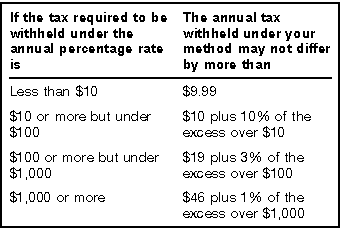You may use various methods of figuring income tax withholding. The methods described below may be used instead of the common payroll methods
provided in Circular E. Use the method that best suits your payroll system and employees.
Annualized wages.
Using your employee's annual wages, figure the withholding using the Percentage Method, Table 7-Annual Payroll Period, in Circular E. Divide
the amount from the table by the number of payroll periods, and the result will be the amount of withholding for each payroll period.
Average estimated wages.
You may withhold the tax for a payroll period based on estimated average wages, with necessary adjustments, for any quarter. For details, see
Regulations section 31.3402(h)(1)-1.
Cumulative wages.
An employee may ask you, in writing, to withhold tax on cumulative wages. If you agree to do so, and you have paid the employee for the same kind
of payroll period (weekly, biweekly, etc.) since the beginning of the year, you may figure the tax as follows:
Add the wages you have paid the employee for the current calendar year to the current payroll period amount. Divide this amount by the number of
payroll periods so far this year including the current period. Figure the withholding on this amount, and multiply the withholding by the number of
payroll periods used above. Use the percentage method shown in Circular E. Subtract the total withholding calculated from the total tax withheld
during the calendar year. The excess is the amount to withhold for the current payroll period. (See Rev. Proc. 78-8, 1978-1 C.B. 562, for an example
of the cumulative method.)
Part-year employment.
A part-year employee who figures income tax on a calendar-year basis may ask you to withhold tax by the part-year employment method. The request
must be in writing and must contain the following information:
- The last day of any employment during the calendar year with any prior employer.
- A statement that the employee uses the calendar year accounting period.
- A statement that the employee reasonably anticipates he or she will be employed by all employers for a total of no more than 245 days in all
terms of continuous employment (defined below) during the current calendar year.
Complete the following steps to figure withholding tax by the part-year method:
- Add the wages to be paid to the employee for the current payroll period to any wages you have already paid the employee in the current term
of continuous employment.
- Add the number of payroll periods used in step 1 to the number of payroll periods between the employee's last employment and current
employment. To find the number of periods between the last employment and current employment, divide (a) the number of calendar days between the
employee's last day of earlier employment (or the previous December 31, if later) and the first day of current employment by (b) the number of
calendar days in the current payroll period.
- Divide the step 1 amount by the total number of payroll periods from step 2.
- Find the tax in the withholding tax tables on the step 3 amount. Be sure to use the correct payroll period table and to take into account
the employee's withholding allowances.
- Multiply the total number of payroll periods from step 2 by the step 4 amount.
- Subtract from the step 5 amount the total tax already withheld during the current term of continuous employment. Any excess is the amount to
withhold for the current payroll period.
(See Regulations section 31.3402(h)(4)-1(c)(4) for examples of the part-year method.)
Term of continuous employment.
A term of continuous employment may be a single term or two or more following terms of employment with the same employer. A continuous term
includes holidays, regular days off, and days off for illness or vacation. A continuous term begins on the first day an employee works for you and
earns pay. It ends on the earlier of the employee's last day of work for you or, if the employee performs no services for you for more than 30
calendar days, the last workday before the 30-day period. If an employment relationship is ended, the term of continuous employment is ended, even if
a new employment relationship is established with the same employer within 30 days.
Other methods.
You may use other methods and tables for withholding taxes, as long as the amount of tax withheld is consistently about the same as it would be
under the percentage method shown in Circular E. If you develop an alternative method or table, you should test the full range of wage and allowance
situations to be sure that they meet the tolerances contained in Regulations section 31.3402(h)(4)-1 as shown in the chart below.

Previous | First | Next
Publication Index | 2001 Tax Help Archives | Tax Help Archives | Home
